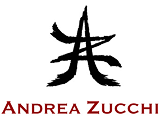Marco Meneguzzo, In the flow of images, catalogo della mostra / exhibition catalogue, Obraz, Milano.
Chance is an occurrence that is hard for man to accept. The creators of myths, astrologists and psychoanalysts know this for a fact.
Thus, when two or more images, greatly distanced from each other, are purposely brought together and forced to live side-by-side on one canvas, we cannot help but activate a mental process, which seeks possible relationships between them. Pure and simple chance, that of dadaist poetry, formed from words extracted from a hat, is unbearable to the point that even in this case – of poetry, that is – the words and sentences formed in this manner took on a meaning that they did not have within the hat.
This is the way Andrea Zucchi’s images work.
Naturally, the first temptation is to uncover the mystery by directly asking the author the motivation behind his decision, but Zucchi’s words do not help. He seems sincerely embarrassed by such a question, which he has apparently never asked himself. “I am fascinated by certain images,” he says, “and I make them mine. I don’t know why I put them together…”
Now, presented with such a disarming declaration, the possibilities of further investigation take two paths, not always opposing, but certainly quite separate: the psychological path and the linguistic, formal, structural.
Why confront the image of a mite, enlarged thousands of times, with the Guggenheim of Bilbao? Or a marine microorganism on the cloud rising from the collapse of the Twin Towers? Or a Hindu deity with a natural gas refinery?
The psychological path should penetrate Zucchi’s subjectivity, to discover his preferences, impulses, suggestions, individual and personal stories behind the apparent randomness of his choices… but, after all, does it really matter to us? The work is there and the umbilical cord with the author has been severed.
If anything, that which is most interesting – beyond “our” impulses, which cause us to prefer one of Zucchi’s works over another because perhaps we like flamingos or Egyptian civilization, whereas we find insects or anatomic dissections horrible – is the organization of “random” images into a composite system that appears intuitively and emotionally coherent.
The first hypothesis – as mentioned above – is that, ultimately, the images are not actually random, but possess hidden relationships, not immediately visible. Here are a few: the antique and the modern; nature and culture, united in violence; or rather, when examined in detail, in Zucchi’s works there is a particular presence of “armored” figures, covered plated mail or by a mask protecting them from the external world – real or metaphorical – which range from the invisible tortoise shell of the smallest insects to sixth-century armor, from protective clothing of biological warfare or afghan burkas to Tutankhamon’s mask, or even Frank O. Gehry’s titanium covering for Bilbao.
And nonetheless, this is, in effect, part of that which we have defined as a psychological aspect of the work, which naturally touches upon our own characters, our stories, but which alone does not provide sufficient “cohesion” of the compositional elements.
Reference was made above to a famous Dadaist experiment; someone – Mimmo Di Marzio – in a recent text, spoke of Zucchi’s as a surrealist approach to the combination of images. Could it therefore be “nonsense” which motivates the juxtaposition of these images?
I believe not.
In order for “nonsense” to make sense (excuse the pun…), it is necessary for the boundary between groups of words or images of a certain coherence to be well codified and distinct from those, which do not share it. If this boundary was well defined during the Dadaists’ great laugh or the Surrealists’ meticulous, introspective lesson, it is no longer so today. That is why such citations can only serve as distant similarities, created so as not to feel completely lost in a new context, but nothing more. In fact, “nonsense” does not make sense today because the quantity of images proposed daily is immeasurable and impossible to be organized. That is why it is perhaps more current and better suited to the present situation to speak of “flow”, which is a neutral term, just as our indifference towards images in general may be neutral (!), whether they represent a terrorist attack or the latest television fiction.
Zucchi, as all of us, lives within this flow of images, and his declaration of a “non-choice” of images, or rather, of a choice dictated by motives that he is not concerned with investigating, suddenly gains meaning. If anything, that which unites these extremely distant images is a sort of colored “connective fabric”, comprised of those abstract segments, that certain “electronic disturbance” formed by rectangles superimposed on the image, or by that decorative “filling” that brings dimensionally different images back to the standardness of the rectangle canvas.
As with a rotogravure, it is the pattern which is drawn, the graphic that induces the eye and then the mind to connect the images, to “frame” them into a group of figures otherwise liable to blend into the next service without trauma. In the same way, the apparently marginal aspect of Zucchi’s work, which is the graphic form of his images, acquires a dignity equal to, if not greater than, that of the image itself. That is the work’s “continuum”, whereas the image, as evident as it may be in the foreground, could actually be exchangeable.
So, the painting paradoxically becomes a “frame” of itself. It serves to make the selected images real, (almost) exactly as occurs in the supplement to the Corriere –with one difference, not only technical, but also ethical:that paintings last much, much longer.

